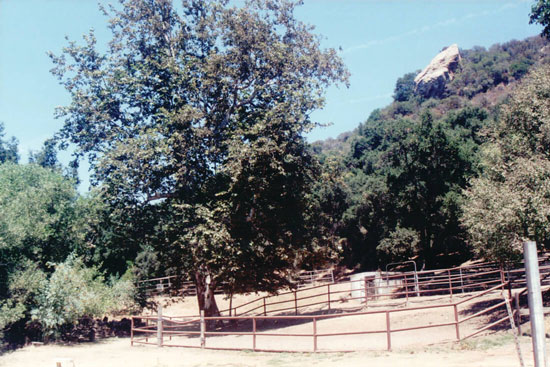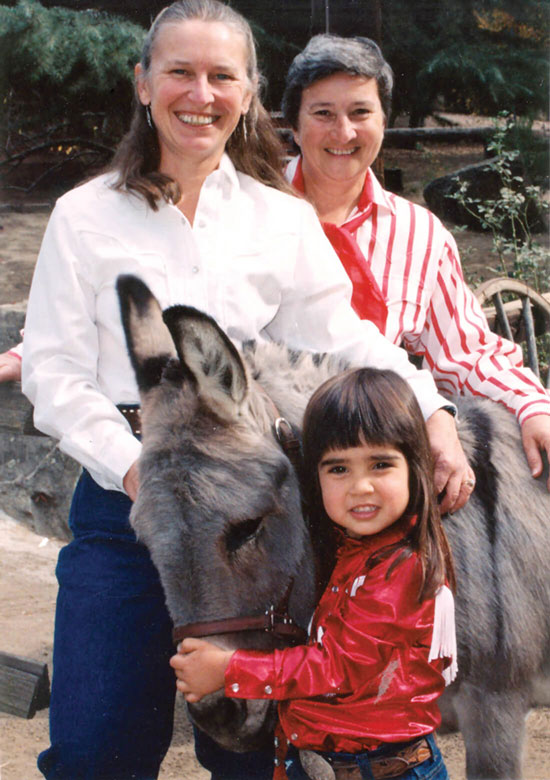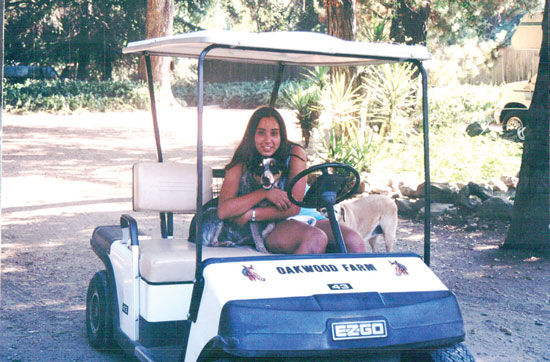The Stone House, Part 8: ‘Ingrid Lindquist and Dede Potvin’ | |
The Stone House, Part 8: ‘Ingrid Lindquist and Dede Potvin’The Stone House, Part 8: ‘Ingrid Lindquist and Dede Potvin’
By Pablo Capra
In the early 1970s, Marvin and Judy Zeidler rented the stone house to a horse trainer, who grew marijuana on the property.
In 1972, the horse trainer left, and they rented to a lesbian couple: Ingrid Lindquist (b.1946) from Los Angeles, and Dede Potvin (b.1939) from Springfield, MA. Dede remembers, “It took about a year for random people to stop driving up at all hours of the day and night looking to buy.” Ingrid and Dede, with Erica hugging a donkey, December 1990 |
When the two women moved in, they found a man sleeping on the kitchen counter. “We were a bit afraid to check on him, thinking he might be dead, but he was just hung over. So that night, we went out for pea soup and homemade bread at the Post Office Cafe,” Ingrid said.
|  After a year, the Zeidlers announced that they had sold the stone house. Fortunately for the women, the buyer’s check bounced, and they were able to buy the house themselves. “We got a copy of the early-1900s lease. It said only whites could live there,” revealed Ingrid, whose family had been in Topanga almost that long. Sometime between 1931-36, her grandparents Nels and Magdalene Lindquist tried to buy the Topanga Mineral Springs Tavern at Horseshoe Bend. Her parents Robert “Jerome” and Dorothy Lindquist briefly lived at the Tavern. One day, while Jerome was at work, Dorothy made an autumnal centerpiece for their table, only to find out that the leaves she’d collected were poison oak.
In the early 1940s, Ingrid’s parents and grandparents bought houses on Topanga Lane in Lower Topanga, where she learned to ride horses. Her house was destroyed in the 1969 flood.
“I lost my corral and needed a new riding property to teach students. Before moving to Old Topanga, I managed a stable in Rustic Canyon. I met Dede there when she signed up for my class. My other students included Don Murray and Hope Lange’s daughter Patty, and the Days of Our Lives soap-opera actress Patricia Barry.”
In 1981, Dede started a printing business in Chatsworth called Printing Safari that she ran for 30 years.
The women raised their adopted daughter Erica (b.1987) in the stone house. Ingrid had followed a lawyer’s advice, but not her conscience, when she adopted Erica as a single parent in 1988. Four years later, Ingrid and Dede became one of the first lesbian couples to go back to court to make the adoption joint.
Erica grew up playing with all the animals on the ranch that they called Oakwood Farm. “Besides the horses, we had six peacocks (Whites, Indians, and Pies), goats, sheep, mini-mules, and donkeys. We had a pig named Bacon and a pig named Junior. A mini Noah’s Ark,” Dede said.
Keeping animals also meant a lot of dashing outside to frighten away dogs, coyotes, and mountain lions (spotted twice).
The last family to raise children in the stone house were the Mazets, the original owners, 100 years ago. The women made several improvements to convert it back to a family home.
“We tore down the entire back of the house and rebuilt it as a log cabin. Before that, it was a shack with no insulation or space in the walls for electricity. There were windows decoupaged to look like stained glass, wall paneling painted in red and green watercolors, an aqua kitchen counter, and black lights. The back porch was dirt, and the back bedroom that was L-shaped, had dirt in the bottom of the L. Coincidentally, the grain of the wood cupboard looked just like Charles Manson,” Ingrid said.
In the late 1970s, a flood washed out the bridge that was part of their driveway. Local contractor Dick Sherman built a larger bridge to span the widened creek bed.
They’d heard that fires had nearly destroyed their ranch, and burned a barn, so they prepared to defend their home when the Old Topanga Fire came in 1993. “We planned to survive a fire in the 1920s food-storage bunker,” said Dede. The first minutes of the conflagration were the scariest for Ingrid, who spotted the smoke while she was out riding her horse. Trying to return home, she risked getting hit as the road turned into a racecourse. The fire stopped just across the street from the stone house, then changed direction and ravaged Malibu.
In 1994, the Northridge Earthquake collapsed their chimney and left cracks in the stone house.
“We ignored experts who advised us to demolish walls or add posts that would have changed the look of the house, leaving these problems for the next owner to fix,” Ingrid said.
A couple of times, film companies rented their property. One film, in the early 1970s, was a Navy recruiting commercial that featured Ingrid’s horses. “I turned down other offers of folks wanting to film on the property because the crew came in to use our phone too often,” Dede said.
Another film was the TV movie, Elvis (1979). Shot in December 1977, shortly after the singer’s death, it starred Kurt Russell and was directed by John Carpenter. In one scene, a boy actor, playing young Elvis, looks into the creek and sees a mirage of his stillborn twin.
The neighborhood was full of characters.
Neighbor Gary Gunn Sr. was their handyman. One of his three children, Gary Gunn Jr., later also worked on the stone house property. He named his son Tommy Gunn.
The “Fifth Beatle,” Billy Preston (b.1946), brought his horse over so Ingrid could help it give birth. The mare was named Fancy Lady after the song he was recording at the time.
Across the street lived Patty Davis (b.1952), the daughter of California Governor and future President Ronald Reagan. From 1974-75, Davis was in a relationship with Eagles guitarist Bernie Leadon (b.1947). Her mother Nancy Reagan famously disowned her for living with a man before marriage. The Eagles album, One of These Nights (1975), has a song that Davis co-wrote called
“I Wish You Peace.”
In Bonnell Park lived the Chandlers, who prided themselves on their country lifestyle. “Ralph Chandler judged his wealth by his woodpile. When you went over for a visit, his wife Dorothy would shoo the chickens off the couch,” Ingrid said.
The Rhodes family—Bill, Rita, and their sons Randy, Sean, and Patrick—had previously been neighbors of Ingrid on Topanga Lane. They played volleyball in the back of the stone house property so often that the running joke was that they should buy the parcel. Bill’s second wife, Mary Colvig, was publisher of the Topanga Messenger newspaper until it was dissolved on December 1, 2016, 40 years to the day since it began in 1976.
Ingrid and Dede enjoyed researching their house’s history and inviting groups over for talks. In the 1990s, they met Doris Weber Fredendall (1910-2003) in a Santa Monica nursing home. Almost 90 years old, she shared memories of living on the ranch in the 1920s and many rare photos. The women contributed this information to The Topanga Story.
In 2000, the women sold the stone house. “I was tired of driving. Sometimes the road was out for nine months,” Dede said. Today, they live in Tehachapi, CA. Their daughter, Erica, attended Whittier College, Oxford University, and Bristol University, and is now an Art History professor at Taft College.
Pablo Capra is the Archivist for the Topanga Historical Society and author of “Topanga Beach: A History” (2020). More at topangahistoricalsociety.org.  | | | | | | | | | | | | | |
|
|
|
|
|
|
|
 |
|
|
|
| | |
|
|










